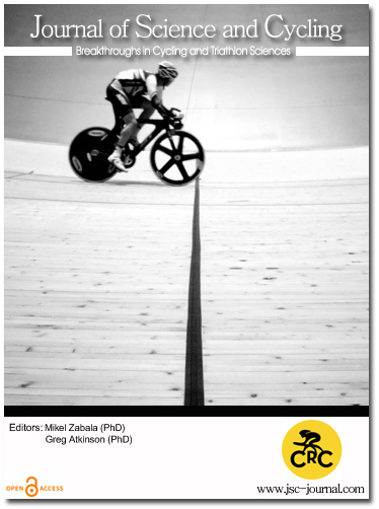The effect of time-trial duration on aerodynamic drag
Keywords:
cycling position, inertial motion unit, aerodynamic drag, time-trialAbstract
Purpose: Aerodynamic drag is the main resistance (80-90 %) among the total resistive forces (RT, N) opposing motionon level ground in cycling (Debraux et al. 2011). To reduce air resistance, cyclists adopt a characteristic time trial (TT)
position on the bicycle to decrease the frontal area. The bike frame and the components only accounts for about 30 %
of the total drag of the cyclist-bicycle system. Thus, the cyclist position has a great importance in the performance on
flat terrain to overcome at the maximum the air resistance (Oggiano et al. 2008). Many research have studied the effect
of the aerodynamic position or equipment’s on the air resistance but to the best of our knowledge, no study has yet
reported the effect of the duration of the exercise on aerodynamic drag. The aim of this study was to analyse the effect
of time-trial duration on aerodynamic drag. We hypothesized that the more the duration of exercise is long the more
the fatigue increases involving an alteration of the effective frontal area (ACd, m2) and accordingly a decrease of
performance.
Methods: 9 elite road cyclists performed all testing session with their personal TT bike on a 200 m covered velodrome
(Bourges, France). The bicycle was fitted with a rear wheel composed of a Powertap G3 hub (CycleOps, Madison,
USA) for the measurement of speed (V, m.s-1) and power output (PO, W). Firstly, the cyclists performed a discontinuous
incremental exercise at different V to determine the rolling resistance coefficient (Cr) from the RT-V2 linear regression
method (Grappe et al. 1997). Then, the Cr was fixed to compute the ACd during three TTs of different durations
according to the cyclists’ categories (table 1). The effects of TT duration and time on ACd, V and PO were tested using
a two-way analysis of variance (ANOVA).
Results: There was no significant effect of TT duration and time on ACd. The largest decrease in ACd was during TT1
(-2.9 %). PO and V were significantly influenced by TT duration (p < 0.001). The mean V was significantly different (p
< 0.001) in all TT durations whereas the mean PO was significantly higher (p < 0.001) in TT1 compared to TT2 (+20.5
%) and TT3 (+28.2 %). A significant correlation was measured between V and the PO/ ACd ratio in TT1 (r = 0.94, p <
0.001), TT2 (r = 0.95, p < 0.001) and TT3 (r = 0.97, p < 0.001).
Conclusions: The main results show that the mean ACd decreased non-significantly over time for all the TT durations
suggesting that the position of the cyclists was not altered during the three events. According to unpublished studies
conducted in our lab, wind tunnel sessions have demonstrated that the ACd decreases by a mean of 0.5 % per 1 km.h-
1 for speeds between 40 and 60 km.h-1. Even more, by applying a correction coefficient on ACd, the lowest value (-
2.9 %) will be reduced to -2.3 % which reinforces the fact that ACd remains relatively stable during the effort. The strong
correlations between V and the PO/ACd in the three TTs demonstrate that the more the PO/ ACd was high, the more
the V was high and the performance was improved (Peterman et al. 2015). Thus, the balance between PO and ACd is
a parameter that must be optimised taking into account both the training process and aerodynamic resistance. To be
efficient in a TT, the cyclist will find the better aero-position on his bike being able to develop the most important level
of PO
Downloads
Published
How to Cite
Issue
Section
Copyright (c) 2017 Journal of Science and Cycling

This work is licensed under a Creative Commons Attribution-NonCommercial 4.0 International License.
Authors contributing to Journal of Science and Cycling agree to publish their articles under a Creative Commons CC BY-NC-ND license, allowing third parties to copy and redistribute the material in any medium or format, and to remix, transform, and build upon the material, for any purpose, even commercially, under the condition that appropriate credit is given, that a link to the license is provided, and that you indicate if changes were made. You may do so in any reasonable manner, but not in any way that suggests the licensor endorses you or your use.
Authors retain copyright of their work, with first publication rights granted to Cycling Research Center.






